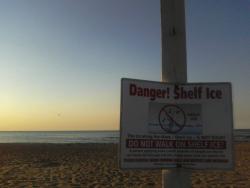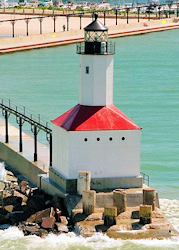  |
 Oct 25 2012, 09:01 AM Oct 25 2012, 09:01 AM
Post
#1
|
|
 Spends WAY too much time at CBTL       Group: Admin Posts: 16,425 Joined: 8-December 06 From: Michigan City, IN Member No.: 2 |
More at link
http://articles.chicagotribune.com/2012-10...ron-river-water QUOTE In fact, recent U.S. Army Corps of Engineers reports found that water levels on Lakes Michigan and Huron touched the all-time low for October one day last week and are likely to recede to record levels in the coming months due largely to this year's dry winter and relentlessly arid summer. As the water has ebbed, more than recreational fishers have taken note. Submerged rocks, trees and debris already have surfaced — new fixtures along the widening shores. Lakers carrying weighty cargo, like coal, iron ore and limestone, have had to lighten loads to make it to harbor. And for a few days this month, the corps limited the use of the Chicago Harbor Lock to prevent river water from running back into the lowered lake. Though the lows have been driven by this year's weather, Lakes Michigan and Huron have drifted beneath their long-term average since the late 1990s, stoking worries that the Great Lakes, which contain a fifth of the world's surface fresh water — will become a consistently diminishing resource in the coming decades. |
 May 1 2013, 08:31 AM May 1 2013, 08:31 AM
Post
#2
|
|
 Spends WAY too much time at CBTL       Group: Admin Posts: 16,425 Joined: 8-December 06 From: Michigan City, IN Member No.: 2 |
http://www.theglobeandmail.com/news/politi...rticle11646229/
QUOTE Canada and the United States should look at building a new structure in the St. Clair River to raise water levels in Lake Huron and Michigan by as much as 25 centimetres, the commission in charge of the Great Lakes says. A recent report from the International Joint Commission, which is responsible for shared U.S. and Canadian water issues, responds to growing frustrations raised by residents and cottagers who own property on Lake Huron and Michigan. Water levels there have declined by an estimated 23 centimetres relative to Lake Erie over the past several decades, damaging wetlands and hurting local businesses. More Related to this Story The report concluded that large-scale dams to regulate flow between the lakes would be too expensive and could do further environmental damage. Instead, it suggested that governments look at the feasibility of establishing an engineered structure in the St. Clair River aimed at gradually raising water levels in Lake Michigan and Lake Huron over a 10-year period. “Lake Michigan-Huron water levels now have been well below average long-term levels for more than a decade,” says the report, which was released on Friday. “While an extended period of low levels is not unprecedented, various economic sectors and the public are concerned about the serious adverse effects of these low water levels.” Water levels in Huron and Michigan have remained below average for the past 14 years, and hit a record low in January, according to the commission. The economic effects in the area have been significant, with reports that some commercial vessels are carrying less than their capacity when they travel through the Great Lakes, and that marinas have been forced out of business because their customers can no longer reach them by boat. In addition to advocating further study of a new structure in the St. Clair River, the report’s authors suggest the government undertake continuing studies of the Great Lakes and prepare to help communities in the area adapt to changing water levels. The recommendations are based on a five-year scientific study of the Great Lakes basin and public hearings with residents in the region. While the commission did not recommend a specific structure for the St. Clair River, its report listed options that included an inflatable “flap gate.” The gate could be installed in the St. Clair River between Stag Island and the eastern shore, according to an analysis conducted for the commission. It could be raised from the river bed by filling it with compressed air, which would slow the movement of water through that part of the river. The analysis suggests the total cost of an inflatable gate would range from about $134-million to $171-million. The problem of low water levels is often attributed to historical dredging in the St. Clair River, as well as long-term erosion, and sand and gravel mining. Those changes increased the flow through the river, lowering the overall water level in Michigan and Huron by an estimated seven to 14 centimetres, according to the commission. At the same time, gradual and very long-term changes in the land profile resulted in another drop of four or five centimetres. But the biggest single contributor to declining water levels is changing climate patterns, which researchers estimate took nine to 17 centimetres out of Huron and Michigan between 1963 and 2007, in part because a trend toward shorter winters and hotter, drier summers has contributed to greater evaporation from the lakes. The U.S. chair of the commission, Lana Pollack, declined to approve the group’s recommendations, in part because she said it does not put enough emphasis on climate change. While she supports the general content of the report, Ms. Pollack said she is worried that it could raise “false expectations” that structures can resolve persistently low water levels. “The public has come to embrace some unrealistic expectations that we can engineer a change in water levels if we only put our minds to it,” she said, adding that she is also concerned about possible downstream effects. Wasaga Beach mayor Cal Patterson said he is encouraged by the report, but recognizes that it would not affect his community in the short-term. Mr. Patterson was part of a group of mayors from the Georgian Bay area that met with Foreign Affairs Minister John Baird on Monday and asked for $10-million in federal funding to help with dredging and other maintenance costs related to the low water levels. (The mayors have also asked for another $10-million from the province). “Something has to happen to impact the economy for 2013, because the water levels are continuing to drop and we’ve got all kinds of issues that are having a negative impact on the economy, jobs and tourism,” Mr. Patterson said. He added that the group did not discuss the commission’s recommendations during the meeting with Mr. Baird, but were told the department is studying the report and planned to issue recommendations of its own. But Sarnia Mayor Mike Bradley, whose city is at the mouth of the St. Clair River, said he is worried about the impact a man-made structure like an inflatable gate could have downstream. “I think it’s playing Russian roulette with the Great Lakes,” Mr. Bradley said in an interview. “... Lake St. Clair and Lake Erie are shallow enough to start with, and sometimes you have to let nature be nature.” Mr. Baird’s office referred requests for comment to the Department of Foreign Affairs, where a spokeswoman said the department is still reviewing the commission’s report. “We view this as an issue of significant importance to the economy and to quality of life for people living in the Great Lakes Basin. As such, we will review the IJC report carefully and respond in due course,” Emma Welford said in an e-mailed response. |
 May 2 2013, 11:31 AM May 2 2013, 11:31 AM
Post
#3
|
|
 Really Comfortable      Group: Members Posts: 1,177 Joined: 19-November 09 Member No.: 969 |
 |
  |
1 User(s) are reading this topic (1 Guests and 0 Anonymous Users)
0 Members:
| Lo-Fi Version | Time is now: 25th April 2024 - 03:06 PM |
Skin Designed By: neo at www.neonetweb.com
Invision Power Board
v2.1.7 © 2024 IPS, Inc.








